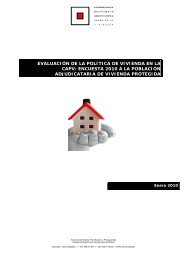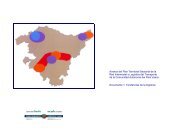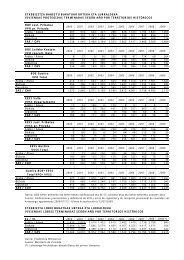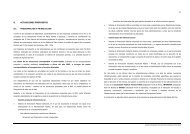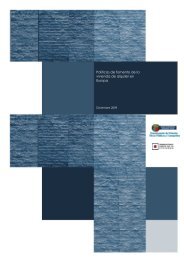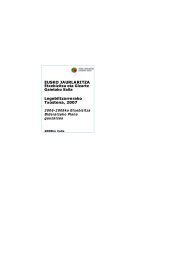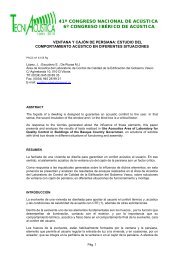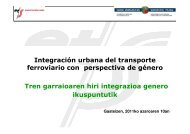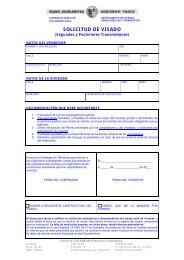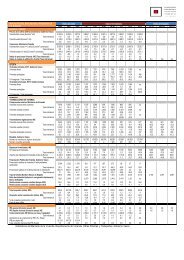2. análisis de la situación actual de la red viaria - Garraioak
2. análisis de la situación actual de la red viaria - Garraioak
2. análisis de la situación actual de la red viaria - Garraioak
You also want an ePaper? Increase the reach of your titles
YUMPU automatically turns print PDFs into web optimized ePapers that Google loves.
NS<br />
CRITERIOS DE DETERMINACIÓN DE NIVELES DE SERVICIO<br />
Porcentaje <strong>de</strong> tiempo consumido<br />
en seguimiento (PTSF)<br />
Velocidad media <strong>de</strong><br />
recorrido (ATS) (km/h)<br />
A ≤ 35 > 90<br />
B > 35 – 50 > 80 – 90<br />
C > 50 – 65 > 70 - 80<br />
D > 65 – 80 > 60 – 70<br />
E > 80 ≤ 60<br />
Fuente: TRB Manual <strong>de</strong> Capacidad 2000.<br />
Nota: Se asigna NS F cuando el flujo exce<strong>de</strong> <strong>la</strong> capacidad <strong>de</strong>l tramo.<br />
La <strong>de</strong>terminación <strong>de</strong> <strong>la</strong> velocidad en flujo libre (FFS) es <strong>la</strong> teórica que <strong>de</strong>sarrol<strong>la</strong>ría un vehículo en el<br />
tramo si <strong>la</strong> <strong>de</strong>nsidad <strong>de</strong>l tráfico fuera nu<strong>la</strong>, es <strong>de</strong>cir, si no concurrieran otros vehículos. Este valor se obtiene<br />
a partir <strong>de</strong> <strong>la</strong> siguiente expresión:<br />
siendo:<br />
FFS = BFFS-<br />
f LS - f<br />
FFS <strong>la</strong> velocidad estimada en flujo libre (km/h).<br />
BFFS <strong>la</strong> velocidad básica en flujo libre, asimi<strong>la</strong>ble a <strong>la</strong> específica (km/h).<br />
fLS el factor <strong>de</strong> ajuste por anchura <strong>de</strong> carril y anchura <strong>de</strong> arcén.<br />
fA el ajuste por frecuencia <strong>de</strong> accesos.<br />
La <strong>de</strong>terminación <strong>de</strong> <strong>la</strong> tasa <strong>de</strong> flujo <strong>de</strong> <strong>de</strong>manda en el periodo que se <strong>de</strong>sea estudiar se realizará mediante<br />
<strong>la</strong> expresión:<br />
siendo:<br />
v<br />
p<br />
V<br />
=<br />
PHF ⋅ f<br />
vp el flujo equivalente <strong>de</strong> automóviles para <strong>la</strong> punta <strong>de</strong> 15 minutos en vehículos equivalentes / hora<br />
V el volumen <strong>de</strong> <strong>de</strong>manda para <strong>la</strong> hora completa, vehículos / h.<br />
PHF el factor <strong>de</strong> hora punta.<br />
fG el factor <strong>de</strong> ajuste por pendiente.<br />
G<br />
⋅ f<br />
HV<br />
A<br />
fHV el factor <strong>de</strong> ajuste por vehículos pesados.<br />
La velocidad media <strong>de</strong> recorrido (ATS) necesaria para <strong>la</strong> <strong>de</strong>terminación <strong>de</strong>l NS se obtiene a través <strong>de</strong> <strong>la</strong><br />
siguiente expresión:<br />
don<strong>de</strong>:<br />
ATS es <strong>la</strong> velocidad media <strong>de</strong> recorrido.<br />
ATS = FFS − 0 , 0125⋅<br />
v −<br />
FFS es <strong>la</strong> velocidad estimada en flujo libre (km/h).<br />
vp el flujo equivalente <strong>de</strong> automóviles para <strong>la</strong> punta <strong>de</strong> 15 minutos en vehículos equivalentes / hora.<br />
fnp es el factor <strong>de</strong> ajuste por porcentaje <strong>de</strong> zonas <strong>de</strong> prohibición <strong>de</strong> a<strong>de</strong><strong>la</strong>ntamiento.<br />
La <strong>de</strong>terminación <strong>de</strong> <strong>la</strong> proporción <strong>de</strong> tiempo <strong>de</strong> seguimiento (PTSF), se realiza mediante <strong>la</strong> expresión:<br />
siendo:<br />
PTSF = BPTSF +<br />
f<br />
d<br />
np<br />
= 100 ⋅<br />
PTSF el porcentaje <strong>de</strong> tiempo <strong>de</strong> seguimiento <strong>de</strong> otro vehículo.<br />
BPTSF <strong>la</strong> estimación básica <strong>de</strong> <strong>la</strong> variable anterior.<br />
P<br />
f<br />
np<br />
−0, 000879⋅v<br />
p [ 1−<br />
e ] + f d<br />
np<br />
fn/dp el ajuste por efecto combinado <strong>de</strong>l reparto direccional <strong>de</strong> los sentidos <strong>de</strong> tráfico y <strong>de</strong> <strong>la</strong>s<br />
restricciones <strong>de</strong> a<strong>de</strong><strong>la</strong>ntamiento.<br />
vp el flujo equivalente <strong>de</strong> automóviles para <strong>la</strong> punta <strong>de</strong> 15 minutos en vehículos equivalentes/hora.<br />
La <strong>de</strong>terminación <strong>de</strong>l nivel <strong>de</strong> servicio se realiza a partir <strong>de</strong> <strong>la</strong> comparación <strong>de</strong> los valores ATS y PTSF con<br />
los <strong>de</strong>scritos para cada NS, teniendo en cuanta que valores superiores a 3.2000 vehículos equivalentes por<br />
hora <strong>de</strong> vp hacen que <strong>la</strong> carretera se consi<strong>de</strong>re saturada y por tanto se corresponda a un nivel <strong>de</strong> servicio F.<br />
Asimismo, si <strong>la</strong> fracción <strong>de</strong> vp que circu<strong>la</strong> por el carril más cargado supera los 1.700 vehículos equivalentes /<br />
hora, también se asigna un nivel <strong>de</strong> servicio F.<br />
En todo el procedimiento se han tomado como datos básicos un porcentaje <strong>de</strong> vehículos para <strong>la</strong> hora <strong>de</strong><br />
cálculo <strong>de</strong>l 6,25% <strong>de</strong> <strong>la</strong> IMD y un reparto por sentidos 60/40.<br />
234<br />
Revisión <strong>de</strong>l Segundo P<strong>la</strong>n General <strong>de</strong> Carreteras <strong>de</strong>l País Vasco



